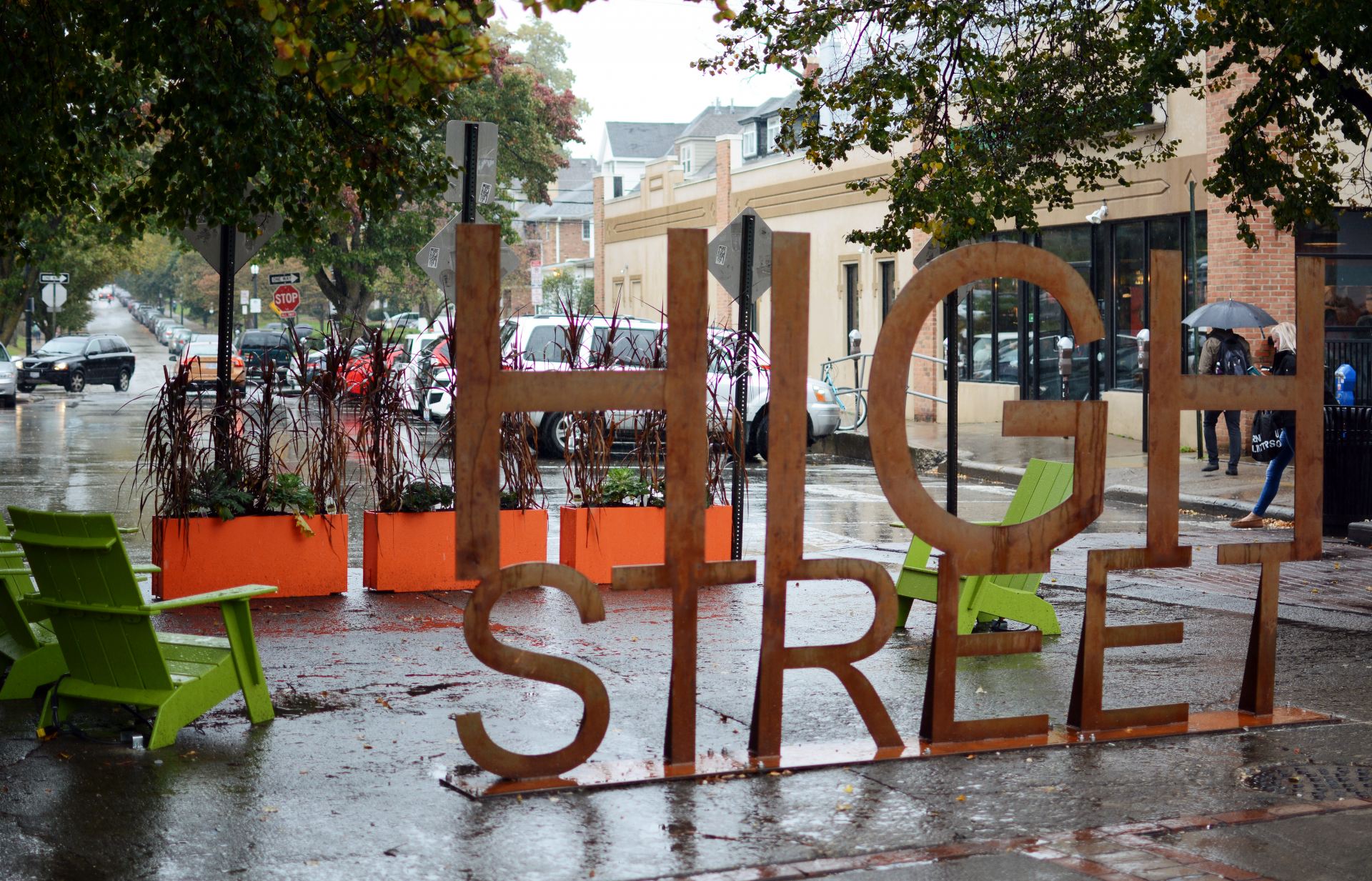
A raw steel “High Street” sign was installed in October by the University District Organization a mural on the south side of SBX. Credit: Kevin Stankiewicz | Editor in Chief
Take a picture of the new public art at East 14th Avenue and High Street. It will last longer.
Installed in October by the University District Organization, the art project — consisting of a raw steel “High Street” sign, a mural on the south side of SBX, plants and four lime green Adirondack chairs — won’t be sticking around forever. It’s only temporary.
That’s because ongoing University District renovations will eventually lead to the demolition of SBX’s current building and the connection of 14th Avenue to High Street, leaving that area less optimal for a sign, mural, plants and chairs. But the UDO’s push for public art in the University District will be sticking around.
“We wanted to look at, ‘What are some kind of test things that we can do throughout the University District to spur people’s interest in public art and test them out to see if they’re feasible for more long-term installations?” said Matthew Hansen, UDO’s executive director. “[14th and High] just seemed like a great starting point and knowing that it was temporary we could put something in there that was low-cost and test it out.”
The public-art initiative was in the works for about a year before the mural and “High Street” sign appeared. Hansen said UDO looked for public input, which included reaching out to Undergraduate Student Government. Hansen said the concrete plaza at the base of East 14th Avenue was suggested as a good place to start by the former USG president and vice president.
With the location decided, UDO contacted Neighborhood Design Center, a nonprofit that provides low-cost design services around the city, and asked the organization to conceptualize a plan for the project. There were only two main guidelines NDC had to follow, said Kerry Reeds, the organization’s director of urban design. One, the design had to be low-cost, and two, because of the impending construction, it had to be easily movable.
Reeds said his team at NDC, which included a number of Ohio State student interns, decided on a sign because it wanted to “identify this as a kind of special zone in High Street.”
The idea to supplement the sign with a nearby mural came during the conceptualization process, Reeds said. NDC realized the south wall of SBX was “a wonderful canvas,” and suggested to Hansen to add artwork on it.
Local artist Stephanie Rond collaborated with Dionne Custer Edwards, a poet who also works at the Wexner Center for the Arts, to transform the wall into a piece of art, complete with flying books and a poem from Custer Edwards. Rond used a technique on the mural known as “wheat pasting,” which is temporary and wears over time.
“It’s going to fade and it’s going to tatter a little bit, but at the end it will go with the fade of the building,” Hansen said.
The green Adirondack chairs and the orange planters were installed after the mural and sign as part of the UDO’s ongoing “beautification projects,” Hansen said.
When the weather warms in the spring, Hansen said another project — “hopefully more of a University District-branded iconic art piece” — planned for near East 13th Avenue and High Street will be installed. He also said UDO wants future projects to involve collaboration with student artists.
“We’ll obviously do open calls for proposals, and those will be open to anybody in Columbus and we hope to have some that are specifically just for students because we’ve got a lot of talented students at OSU and being able to harness their creativity is also a priority in our arts plan,” Hansen said.
As for what happens to the current sign when the construction begins, Hansen said UDO hopes to relocate it, but an exact spot hasn’t been decided.
Reeds wants the sign to find a new home. He also acknowledged some might not find its simple steel design appealing, but said there isn’t going to be a public art display that pleases everyone.
“People are going to think what they are going to think about it,” Reeds said. “They’re either not going to think about it, they’re going to walk right past it and not give it a second thought or they might say, ‘That’s kind of cool,’ or they may say, ‘What the hell is that doing there?’
“You can think whatever you want. It is something that is going to mean something different for everyone.”

